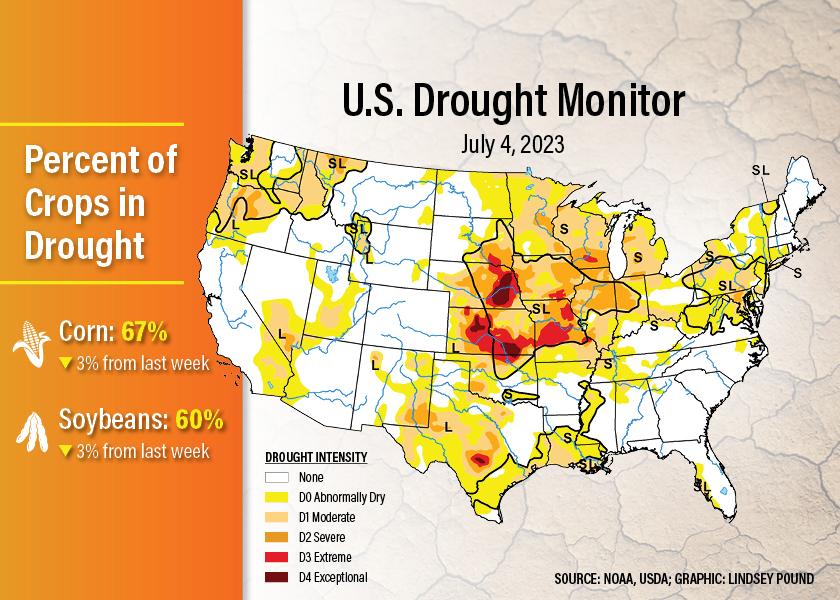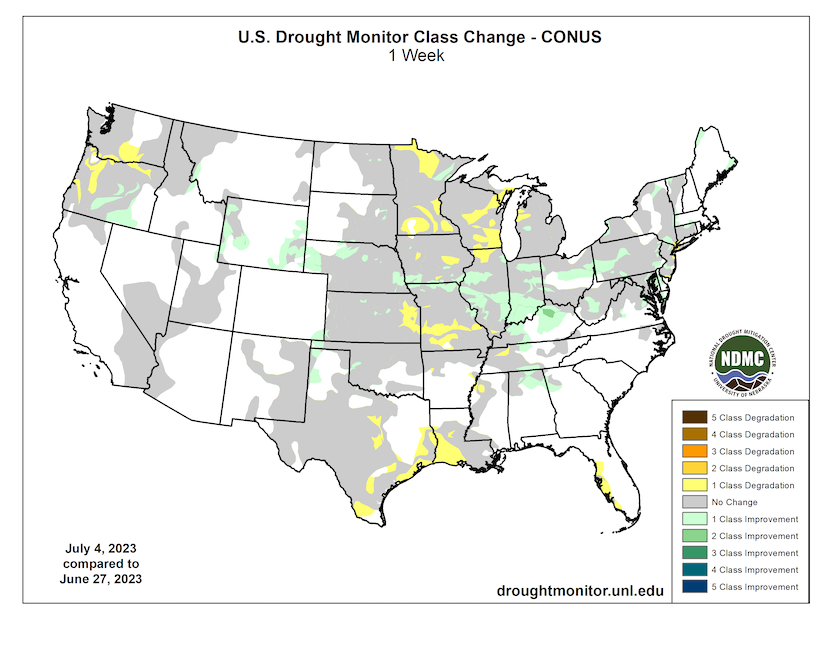Midwest Rains Not Enough to Break Long-Term Drought, 67% of Corn Still Rooted in Drought

Widespread rains finally swept across the Midwest over the past week, but they didn’t put much of a dent into the overall U.S. drought picture with drought percentages still resembling 2012. A slight change in the high-pressure block that’s led to increasing drought conditions this summer could start to give way to more rains in parts of the Corn Belt. However, one meteorologist warns the northern Corn Belt is forecast to see little relief over the next seven days.
The National Drought Mitigation Center now estimates 67% of the U.S. corn crop and 60% of soybeans are still considered to be in drought. That’s a slight improvement from last week, when 70% of corn and 63% of soybeans were covered by drought, but the improvements were minimal at a time when more of the corn crop is starting to tassel.
USDA Meteorologist Brad Rippey says the U.S. corn-in-drought percentage was actually a little higher on November 1, 2022, when 71% of the crop was considered to be in drought. But he points out that was after most of the crop had been harvested. Today, crop conditions are drawing comparisons to 1988, but the drought monitor is showing similarities to 2012 with a few key differences.
“The last time more corn was in drought during the heart of the growing season was, as you might expect, the summer of 2012,” says Rippey. “That year, the U.S. corn production area in drought was at or above 70% each week from July 10 through the end of the calendar year.”
Rippey says 2012 saw more of the U.S soybean crop in drought, but those impacts showed up later in the season.
“A greater percentage of U.S. soybeans were in drought several weeks in late 2022, with a peak of 71% on October 25 and November 1. Of course, this was also after many of the soybeans were harvested,” he says.
Nationally, the latest drought monitor shows minimal improvements nationwide. The amount of the country considered abnormally dry now sits at 87%, nearly a 3-point improvement. D1 (moderate drought) is still parked over 63% of the U.S., less than a point better than last week. D2 (severe drought) is virtually unchanged.
What Will it Take to Break the Drought?
With the drought building up over several months, Rippey points out it will take significantly more rain to see improvements.
“Significant rainfall deficits built up in May and June,” says Rippey. “Recent rains are helping, but normal weekly Midwestern rainfall this time of year is roughly 1 to 1 1/3 inches per week. The two-week Drought Monitor change map shows patchy areas with improvement, mainly in the southern and eastern Corn Belt.”

The latest look at drought across the Midwest shows improvements along the Iowa/Missouri border, eastern and central Illinois, and southern Indiana. Pockets of improvement also fell across northern Texas, southwest Colorado, northern Kentucky and central Ohio.
Portions of Nebraska also saw rain, but 25% of the state is still considered to be in D3 (exceptional drought).
Other areas of the Midwest saw drought grow more severe, including across Minnesota, Wisconsin, eastern Iowa, eastern Kansas and southern Missouri.
More Rain Relief on the Way?
While extremely variable, rains are starting to fall across more of the Midwest. The change is aided by a slight change in the high-pressure block, according to Rippey.
“There have been subtle changes in the North American weather pattern. There is still a high-pressure block, but it has shifted further north and east and is currently centered between Canada and Greenland. That is allowing some cool, dry air to push southward from northern and central Canada,” he says.

Rippey says a strong ridge of high pressure is still in place across the southern tier of the U.S., which will create a battle between cool and warm air.
“Over the next week or so, the heaviest rain will fall near the boundary between the cool Canadian air and the hot air across the nation’s southern tier,” says Rippey. “Recent forecasts are showing the most significant rain falling a bit further south than earlier expectations, which could leave parts of the Midwest – especially the northern Corn Belt – with little rain over the next seven days.”







